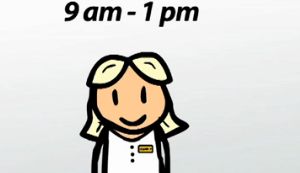Job Flexibility in the Workplace
After you watch the video and know the material, click HERE for the quiz.
It's tough to find the right balance between work and life, but many employers are helping to make that task a little easier. Watch this lesson to learn about job flexibility in the workplace, including flextime, a compressed workweek, and telecommuting.
Job Flexibility
Having a good work/life balance is something that most people value. For many employees, the typical nine-to-five schedule simply does not work for them. Additionally, many of today's organizations are really beginning to recognize the benefits of offering employees family-friendly work options. Employers are finding that an increased awareness of these needs, as well as advances in technology, are helping them to attract and retain quality employees.
By accommodating these individuals and their outside interests and needs, alternative work schedules are used to create job flexibility. For some, part-time work such as job sharing (or twinning) is best. For others, their preferences require shorter workweeks with full-time hours, such as working a compressed workweek, and some even prefer to work from home by telecommuting. Offering employees flexibility for when and where they perform their jobs is a workplace practice that has many benefits for both the employee and the organization.
 |
Flextime and the Compressed Workweek
There are many things that we wish we had more control over in our lives, and time is certainly one of them for most of us. Flextime allows employees the opportunity to determine and control the hours in which they work. One form of flextime is a compressed workweek, which permits employees to work their standard 40-hour schedule in less than a five-day workweek. For example, an employee might work four 10-hour days or three 12-hour days. This option affords the employee an extra day or two off from work while preserving the income of a full-time job, and it also saves them from their commute to and from work on those days. Many people are happy having the extra day off to do errands, leaving their weekends for leisure; however, even with the extra days off, the long days of working can certainly lead to fatigue and burnout. When properly matched, though, the organization benefits from lower absenteeism and improved performance.
Job Sharing or Twinning
Some jobs are better completed with the help of two people. The idea of job sharing, also known as twinning, does just that by dividing one full-time job among two employees. The employees essentially 'share' the job by splitting the hours of the job among two employees; one employee works the first half of the day, week, or month, and the other employee is responsible for the second half. For example, Jill and Jane share the job of a full-time receptionist, but Jill has kids and Jane has an elderly parent that she cares for. Both Jill and Jane only have enough time to work a part-time schedule. Because Jill has kids, she needs to be home with them when they return from school, whereas Jane needs to be with her mom early in the morning until her nurse arrives. Therefore, Jill is able to work the first four hours of the receptionist shift, and Jane works the second half. The organization benefits from having two qualified employees, and Jill and Jane benefit from the flexibility of job sharing.
 |
Telecommuting
One of the fastest-growing ways that employers are providing job flexibility is through telecommuting. Telecommuting allows an employee to work the majority of their work hours, or all of them in some cases, from home or from some other location outside of the office. Employees can connect to the office via computer, fax, phone, or some other mobile device from the comfort of their personal home office. In many cases, telecommuting frees the worker from having to work a set schedule of hours. Additionally, many telecommuters don't have to worry about wearing business attire, traveling to and from work, or having direct, in-person contact with customers or supervisors (outside from maybe an occasional video conference). Telecommuting provides more flexibility in the employee's day to handle more personal responsibilities without having to take time off of work; however, some telecommuters express feelings of isolation. Employees who show high levels of productivity without the need for direct supervision or training and who are self-disciplined make optimal candidates for telecommuting. Telecommuting is a great way to motivate employees who like to be their own bosses and who enjoy the benefits of having a flexible workday. The organization benefits from increased productivity and lower costs relating to the employee workstation.
 |
Lesson Summary
Let's review. Job flexibility is used by employers to offer their employees alternatives to the typical nine-to-five work schedule, enabling the employee to find a better balance between work and life. Flextime allows employees the opportunity to determine and control the hours in which they work.
One form of flextime is a compressed workweek, which permits an employee to complete their standard 40-hour schedule in less than a five-day workweek. For example, an employee might work four 10-hour days or three 12-hour days.
Job sharing, also known as twinning, divides one full-time job among two employees. The employees essentially 'share' the job by splitting the hours among two employees: one employee works the first half of the day, week, or month, and the other employee is responsible for the second half.
Telecommuting allows an employee to work the majority of their work hours, or all of them in some cases, from home or from some other location outside of the office. Telecommuting frees the worker from having to work a set schedule of hours, wear business attire, commute to the office, and have direct, in-person contact with customers or supervisors. Offering employees flexibility for when and where they perform their jobs is a work practice that has many benefits for both the employee and the organization.